Have you ever quilted with silk dupioni? It really is a wonderful fabric for a special use quilt.
Occasionally, you will see an heirloom style dupioni quilt in Sew Beautiful magazine and this one was featured in Creative Needle magazine a few years ago. The only person I have ever known to actually make one was Rebecca Kemp Brent, a frequent and fabulous contributor to machine embroidery magazines. It was a great compliment for her to reproduce this one.
The reinterpretation of traditional quilt designs by using heirloom fabrics and techniques gives a refreshing and elegant twist to favorite old patterns. Testimony to the popularity of the Grandmother’s Fan pattern is the ready availability of vintage quilts of this design. By cutting the spokes of the fans from different fabrics, yesterday’s quiltmaker was able to use her small scraps in a pleasing and interesting design.
The heirloom version of this classic pattern uses silk dupioni scraps and tatted medallions. Dupioni has become very popular for both smocking and heirloom sewing, and many stitchers have small amounts of expensive scraps tucked away awaiting usefulness.
The inspiration for this 45″ square quilted wallhanging was my own collection of dupioni. Brownish pink, almost a pastel copper, is known in antique lace circles as “biscuit” and has always been a favorite of mine. Whenever I saw more coordinating colors, I picked up a piece or two. Finally, I knew I had to stop buying and start sewing. The variety of coordinating colors made the pattern choice easy. However, using dupioni for quilting requires special handling and considerations.
1. Baste by hand if quilt will be laundered before basting threads are removed.~~~~~This quilt was machine basted at the center and along the outer square. Later, the quilt top was immersed in water to remove the marked lines and tumbled dry at a cool setting. When the machine basting threads were removed, a creased line remained in the silk. Many rows of hand stitched basting left no trace after their removal.
Machine basting, with fine thread and a fine needle, was done on the fans, at a point in the construction when no water soluble quilting marks needed to be removed. These basting rows left no telltale creases.
2. Heavily starch scraps for fan spokes or pieces of another pattern.~~~~~~~~Accomplish this by spraying lightly, pressing and repeating the process to get a build up of starch. Spraying too heavily at one time may leave water spots on the silk.
Dupioni ravels very easily. The heavy starch helps prevent fraying of the sides of the fan spokes, which are cut on an angle. Since the fans of the center motif are sewn with an 1/8″ seam allowance, raveling poses a serious problem.
3. Be aware of difference in appearance of pressed and unpressed dupioni.~~~~~The foundation fabric had an entirely different appearance after having been immersed in water and tumble dried. At this point, the quilt had already been layered with batting and backing, so it was impossible to press the silk.. While it maintains its sheen and texture, the crispness of the new fabric is replaced with a lovely softness inherent to laundered, unpressed dupioni.
The fans look best when pressed and crisp. They were appliquéd in place after the machine quilting, after the laundering to remove the marking lines, after the tumble drying so they would not lose this sharp look.
On a traditional Grandmother’s Fan quilt, finishing the curved bottom edge of the fan is not necessary. It is usually covered with a quarter circle. My plan to use the tatted medallions for that circle, dictated that the edge must be pressed under. That was a little challenging as I did not want to stretch the fan.
The medallions were then carefully placed in order to cover the folded curved edge of the fan, then stitched in place, free motion, with ecru Madeira Cotona 80 wt. Thread.
Made in China, the tatted medallions which serve as the bases of the fans were “liberated” from 4-6″ medallions. The larger circular pieces were made by crocheting smaller tatted orbs together and until just recently, have been readily available. By snipping into the chain, it is easy to unravel the crochet and set the tatting free. Lace medallions would make an elegant substitute for the tatting. Short lengths of lace edging could be gathered up into a circle, the raw ends whipped together and perhaps a bit of silk ribbon embroidery over the center.
Traditionally, the fans are appliquéd onto blocks which are seamed into a pieced quilt top. This heirloom version omits the blocks and appliqués the fans directly onto a full-sized top. The machine quilting is done with ivory 50 wt. silk thread in the needle and 60/2 cotton thread in the bobbin. The feather design is done free-motion, one of my favorite and most useful techniques.
The remaining quilting is done in darker silk thread with the feed dogs up and dual feed (or walking foot) engaged. The delicate feather stitch around the fans offers subtle contrast and interesting texture to the quilting relief.
I particularly like the binding on the quilt. No single color seemed quite right for the binding and even after all those fans, I had plenty of small scraps. So from these, I cut 2″ strips of varying length. They were sewn together to make the scrappy, multicolor binding.
If you have any dupioni lying around, making a small quilt would be a worthy project. I think most quilters would enjoy working with the silk texture which is so exotically different from quilters cotton.  I’d love to hear from anyone who has made or plans to make  a silk quilt.

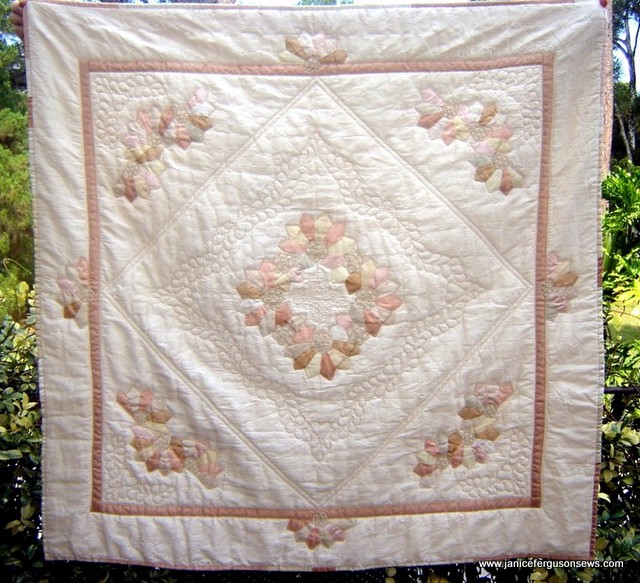
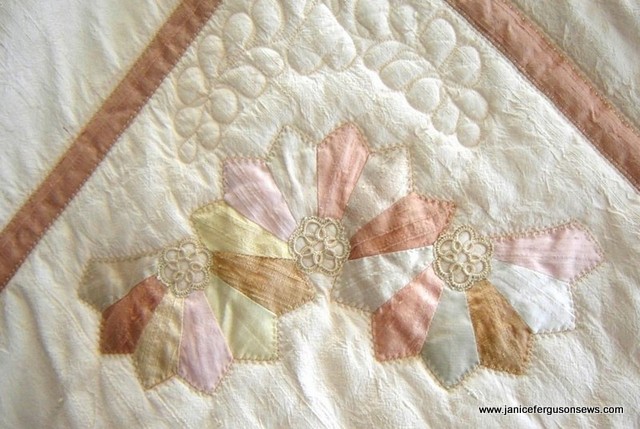
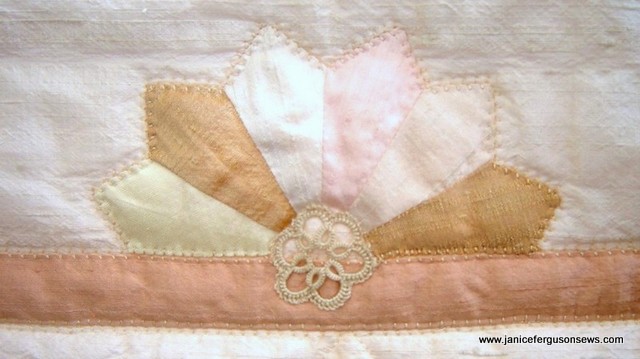
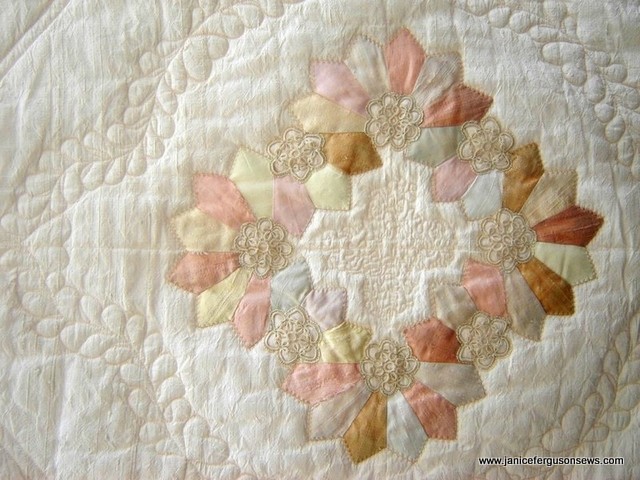
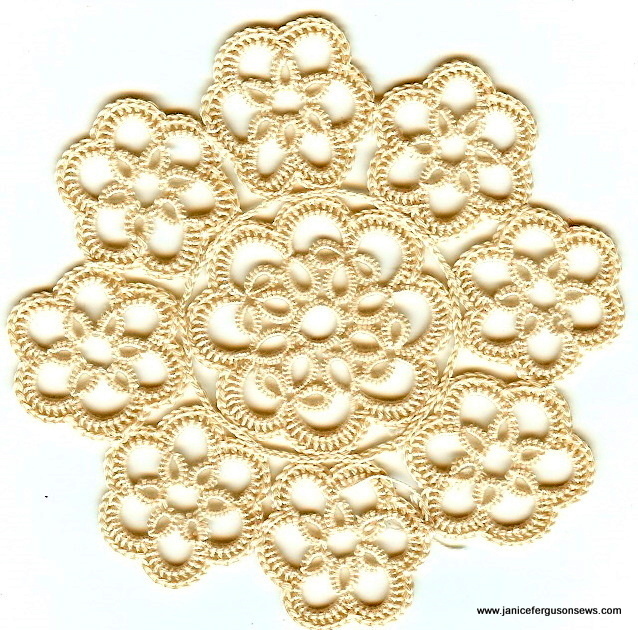

4 responses to “Silk Dupioni Quilt”